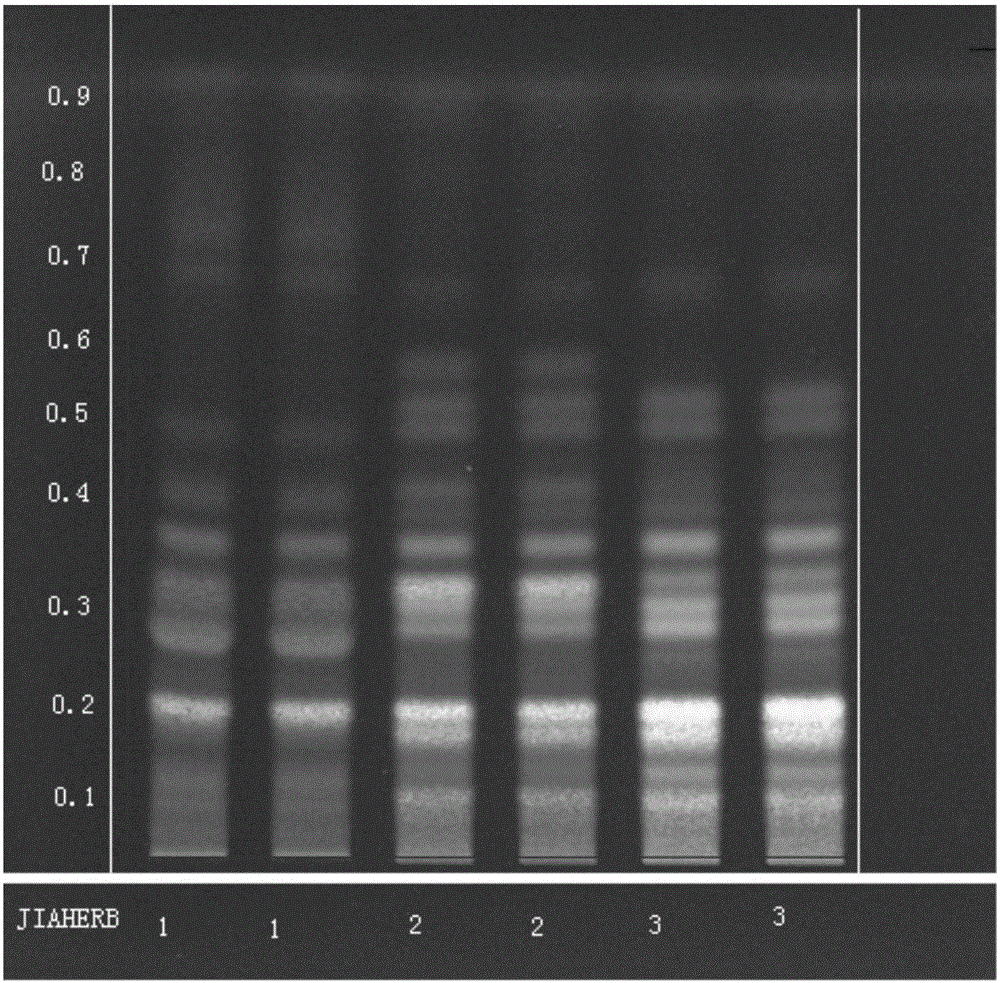Thin layer identification method of rhamnus frangula bark and rhamnus purshiana bark
An identification method and technology of beautiful mice, applied in the direction of measuring devices, instruments, scientific instruments, etc., to achieve the effect of strong specificity, intuitive test results, and simple operation
- Summary
- Abstract
- Description
- Claims
- Application Information
AI Technical Summary
Problems solved by technology
Method used
Image
Examples
Embodiment 1
[0031] Buckthorn bark and buckthorn bark raw materials are crushed through an 80-mesh sieve, then add 6 times the amount of water to reflux and extract for 30 minutes, take it out, let it cool, filter, add 5ml of 1mol / L hydrochloric acid to the filtrate, add ethyl acetate saturated with water The ester was extracted twice, 20ml each time, the ethyl acetate layers were combined, the solvent was evaporated to dryness, the residue was dissolved in methanol, filtered through a microporous membrane, and the filtrate was used as the sample solution. Spot the sample solution on the silica gel G thin-layer plate respectively, and the distance between the spotting origin and the lower edge of the thin-layer plate is 1.0 cm.
[0032] Use ethyl acetate, methanol and water at a volume ratio of (10:1.3:1.0) to mix 20mL of developer, and place the developer in a 10×10cm double-tank development cylinder. The amount of developer in the two tanks should be the same. Seal the development cylind...
Embodiment 2
[0037] Buckthorn bark and buckthorn bark raw materials are crushed through an 80-mesh sieve, then add 8 times the amount of water to reflux and extract for 30 minutes, take it out, let it cool, filter, add 8ml of 1mol / L hydrochloric acid to the filtrate, add ethyl acetate saturated with water The ester was extracted twice, 20ml each time, the ethyl acetate layers were combined, the solvent was evaporated to dryness, the residue was dissolved in methanol, filtered through a microporous membrane, and the filtrate was used as the sample solution. Spot the sample solution on the silica gel G thin-layer plate respectively, and the distance between the spotting origin and the lower edge of the thin-layer plate is 1.0 cm.
[0038] Use ethyl acetate, methanol and water with a volume ratio of (8.0:1.0:0.8) to mix 20mL of developer, and place the developer in a 10×10cm double-tank development cylinder. The amount of developer in the two tanks should be the same. Seal the development cyl...
Embodiment 3
[0043] Buckthorn bark and buckthorn bark raw materials are crushed through an 80-mesh sieve, then add 10 times the amount of water to reflux and extract for 30 minutes, take it out, let it cool, filter, add 5ml of 1mol / L hydrochloric acid to the filtrate, add ethyl acetate saturated with water The ester was extracted twice, 20ml each time, the ethyl acetate layers were combined, the solvent was evaporated to dryness, the residue was dissolved in methanol, filtered through a microporous membrane, and the filtrate was used as the sample solution. Spot the sample solution on the silica gel G thin-layer plate respectively, and the distance between the spotting origin and the lower edge of the thin-layer plate is 1.5cm.
[0044] Use ethyl acetate, methanol and water at a volume ratio of (5:0.8:0.6) to mix 20mL of developer, and place the developer in a 10×10cm double-tank development cylinder. The amount of developer in the two tanks should be the same. Seal the development cylinde...
PUM
 Login to View More
Login to View More Abstract
Description
Claims
Application Information
 Login to View More
Login to View More - R&D
- Intellectual Property
- Life Sciences
- Materials
- Tech Scout
- Unparalleled Data Quality
- Higher Quality Content
- 60% Fewer Hallucinations
Browse by: Latest US Patents, China's latest patents, Technical Efficacy Thesaurus, Application Domain, Technology Topic, Popular Technical Reports.
© 2025 PatSnap. All rights reserved.Legal|Privacy policy|Modern Slavery Act Transparency Statement|Sitemap|About US| Contact US: help@patsnap.com

